[Toward the end of September 2021 I received an email from one Dr. Dennis Low, a London-based photographer and researcher on the niche subject of historic zoo photography.
Dr. Low contacted me because I serve on the advisory board of the European Society for the History of Photography (ESHPh), with which he found himself in contention over an article recently published in its semiannual journal, PhotoResearcher. Dr. Low had drafted an extensive response thereto, which the ESHPh had refused to publish. Given my connection to the organization, he asked, how would I suggest he proceed?

ESHPh logo
I concluded that I could best serve the interests of Dr. Low, the ESHPh, and “the discourse” on photography by making space available here at Photocritic International for him to present his argument in full. (Click here to download a PDF of the original article to which he responds.)
Due to its length, I have divided Dr. Low’s paper into installments. Part 3 appears below. Click here for Part 1, here for Part 2, here for part 4, and here for part 5. When the series concludes, a PDF download of his complete article will become available. — A.D.C.]
•
A Reply to Moritz Neumüller’s ‘”A Stone Thrown At My Head”:
London by Gian Butturini — A Reception History, 1969-2021′ (c)
by Dennis Low
… If the campaign against Gian Butterini’s book London and Martin Parr could be handed over, so, too, could the machinery of that campaign. In 2019, Paul Halliday was an active participant in the small protest outside London’s National Portrait Gallery, briefly referred to by Moritz Neumüller in his article about the debacle (2021, p.153). ‘The people we spoke to outside the @NPGLondon were appalled’[1], wrote Halliday, whom Michiel Kruijt has also revealed as the filmographer for an accompanying video.[2]
Only later, would Halliday recast himself, from a member of a family outing with his daughter Mercedes Baptiste Halliday and his partner, Roxanne Baptiste (Mercedes’ mother), into a third-party witness: ‘I saw the protest outside the #NationalGallery led by young #BlackWomen’[3]; ‘I saw how @LTHdebate was ignored, then belittled for challenging what she and her friends knew to be wrong’[4].
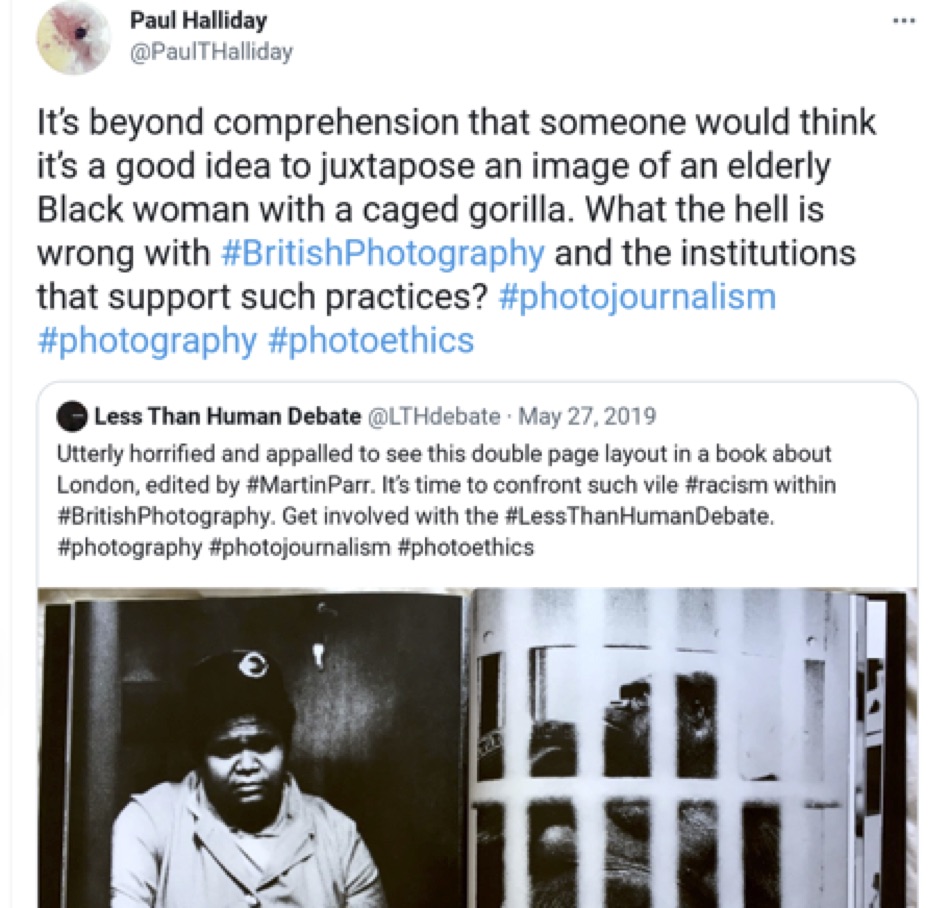
Paul Halliday, Butturini tweet, 5-27-19
•
As we begin to see here, already, in these quotations, the “Less Than Human Debate” (@LTHDebate) account on Twitter would also undergo a metaphorical transfer of ownership. Having begun life as a collective ‘we’, Twitter’s @LTHDebate account soon became interchangeable with Mercedes herself, right up until the present: ‘When people talk about “photographic history”, this will be there’, wrote Halliday, ‘Write your account Ben[jamin Chesterton]. I’m writing mine. @LTHdebate will write hers’[5]; and, more recently, ‘I’ve been approached by Moritz [Neumüller] for an interview along with @LTHdebate’[6].
Interestingly, both users on Twitter and the press at large seemed at least partially aware that everything was not what it seemed regarding the Mercedes narrative. American photography journalist, Andrew Molitor, called out @LTHDebate as a ‘sock puppet account’[7] on no less than two occasions, only to receive, from Halliday and @LTHDebate, clumsily worded responses. ‘So,’ writes Halliday, ‘the @LTHdebate that you describe as a “sock-puppet account” was set up by a young #Black woman’[8]. Similar wording, and a tell-tale first-person singular seem to betray the true identity of @LTHDebate: ‘As I previously said, this account isn’t run by Paul [Halliday], he is just supporting it, as a number of other people are. This account was set up by a young black woman’[9].
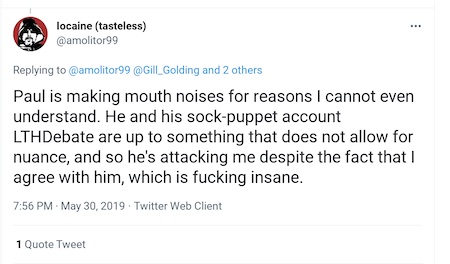
Andrew Molitor, Butturini tweet, 5-30-19
•
![]() Some journalists took up the Mercedes narrative unknowingly and in good faith. Writing for The Art Newspaper, Tom Seymour reported: ‘Mercedes Baptiste Halliday, from London, who is currently a student at University College London, drove an 18-month protest against the book and Parr’s involvement, which led to the prominent photographer stepping down from the Bristol Photo Festival this week’[10]; ‘Mercedes Baptiste Halliday, from Clapham, London, who is currently studying anthropology at University College London, has driven an 18-month protest against a photography book credited as being by Parr and which he promoted for a sustained length of time’[11].
Some journalists took up the Mercedes narrative unknowingly and in good faith. Writing for The Art Newspaper, Tom Seymour reported: ‘Mercedes Baptiste Halliday, from London, who is currently a student at University College London, drove an 18-month protest against the book and Parr’s involvement, which led to the prominent photographer stepping down from the Bristol Photo Festival this week’[10]; ‘Mercedes Baptiste Halliday, from Clapham, London, who is currently studying anthropology at University College London, has driven an 18-month protest against a photography book credited as being by Parr and which he promoted for a sustained length of time’[11].
On Twitter, too, Seymour would lend his support to the Mercedes narrative, tweeting, ‘I told her personally and will say publicly that Mercedes should be proud of herself for raising these concerns’[12]. By September, Seymour was turning to Mercedes’ father for an expert opinion on his own campaign:
“Pandora’s box has been opened,” says Paul Halliday, a photography lecturer at Goldsmiths University of London. “It’s a moment of crisis for photography’s status quo […] A lot of lecturers have been very upset by recent events and are increasingly uncomfortable with how these so-called masters have been traditionally taught,” Halliday says […][13]
•
Seymour and Andy Day were important components in initiating and sustaining the Mercedes narrative. But while they were wittingly or unwittingly disseminating it, other parts of the press seemed wary. Referring to the protest at the National Portrait Gallery, Lanre Bakare, writing for the Guardian, chose not to mention any of the protestors by name.[14] Halliday was incensed: ‘This makes disturbing reading. The @guardian article erases the activism of young #BlackWomen who campaign against racism in #BritishPhotography’[15].
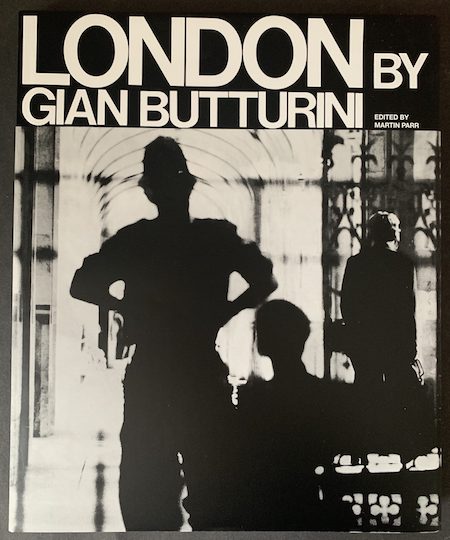
Gian Butturini, London (2017), cover
So, too, was his partner, Roxanne Baptiste (‘Surely the @guardian can at least make an attempt to interview the campaigners @LTHdebate they did the work. Don’t take their voice!’), and the @LTHDebate account: ‘@LTHdebate was set up by young black women fed up with the presentation of racial stereotypes within British Photography. @Lanre_Bakare @Guardian this was a wasted opportunity to talk to young black people about why #BlackLivesMatter’[16].
Conversely, any journalist who attempted to highlight Halliday’s paternal relationship to Mercedes quickly drew ire: ‘Even those who criticise this trend are mobbed’, wrote Manick Govinda for Spiked, ‘Paul Halliday – the father of principal protester Mercedes, and an MA course leader at Goldsmiths – accused me on Twitter of being a ‘brown racist enabler’. He has denounced others for their associations with Parr.’[17]
•
Michiel Kruijt’s long article for the Dutch newspaper, de Volkskrant, is a masterly piece of detective work when it comes to recuperating Halliday’s carefully hidden involvement in the matter, but it only served to confirm what academics, industry insiders, and other interested parties closer to the ground seemed to already know.[18]
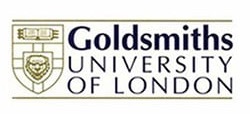 The beginning of the new university year in September 2020 saw a litany of high-profile public complaints levied, not at the undergraduate student, Mercedes Baptiste Halliday, but at her father, Paul Halliday, lecturer at Goldsmiths, University of London. At the time of writing, the ensuing investigation by Goldsmiths’ senior management is in its tenth month. [Note: Seventeenth month as of the date of this publication. — Ed.]
The beginning of the new university year in September 2020 saw a litany of high-profile public complaints levied, not at the undergraduate student, Mercedes Baptiste Halliday, but at her father, Paul Halliday, lecturer at Goldsmiths, University of London. At the time of writing, the ensuing investigation by Goldsmiths’ senior management is in its tenth month. [Note: Seventeenth month as of the date of this publication. — Ed.]
If there is any residual doubt as to whom the campaign against Butturini belonged, it is put to rest by Halliday’s more recent tweets: ‘I, along with 3 other people […] challenged a book juxtaposing a Black woman with a gorilla’[19] he writes; ‘Yes, I was ‘Spiked’ when I challenged a publication that juxtaposed an elderly Black woman with a gorilla’[20].
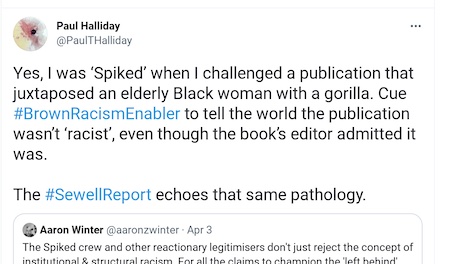
Paul Halliday, Butturini tweet, 4-3-21
•
Neumüller was aware of most, if not all, of the political machinations and backstage personal politics that I’ve described here, but they are, for the most part, actively suppressed in his account. Early on in his article he writes, ‘To my regret, Dennis Low did not release his interview for publication’ (p.138). An important passage, relating to the public complaints made against Halliday, had been carefully redacted from the transcript of my interview and this, as I explained to the editors of PhotoResearcher, was the reason I had been unable to release it for publication. [See the Author’s Note prefacing Part 1 of this essay for details. — Ed.]
In minimising Halliday’s involvement in the campaign against Butturini, Neumüller is able to re-authorise the very same Mercedes narrative that even social media and the press had begun to question and shy away from. Even if Butturini’s detractors lacked an argument to support their allegations, at least, in Mercedes, they had the shape of something: an emotive, against-the-odds story that was easy to get behind; a ‘young, black woman’ protagonist who, coming of age on her eighteenth birthday, might, conceivably, have just a pinch of Jen Reid’s zeitgeist heroism.[21]
The Mercedes narrative legitimised Butturini’s detractors, and kept them respectable. On paper, it superficially resembled a clear, ideological position, fuelled by a defiance of racial injustice. In actuality, it was a subterfuge, a mere foil – albeit one cut from noble principles – to hide the pettiest and basest of motives: the green-eyed monster of professional jealousy.
•
Paul Halliday, by any measure, cuts a strange figure. His career seemed to begin promisingly enough. By his own account, he had, by the age of 17, become ‘the youngest tutor in ILEA (Inner London Education Authority)’[22]. He was commissioned by Channel 4 for Steven Lawrence: Living with the Bunker (1994), a documentary that was warmly received.[23] He taught at Croydon College; was ‘invited to become a visiting Fellow in the Centre for Urban and Community Research’[24] at Goldsmiths; and would take up a position, at Goldsmiths, as programme convenor for the MA Photography and Urban Cultures degree.
 In 2007, he became a director of Photofusion, then one of the UK’s most prestigious photography charities, which enjoyed long-standing National Portfolio of Arts Organisations (NPO) status at Arts Council England. Up until that point, it was a career of which any mid-career academic/photographer would have been justifiably proud.
In 2007, he became a director of Photofusion, then one of the UK’s most prestigious photography charities, which enjoyed long-standing National Portfolio of Arts Organisations (NPO) status at Arts Council England. Up until that point, it was a career of which any mid-career academic/photographer would have been justifiably proud.
•
It is difficult to pinpoint precisely what faltered for Halliday. Perhaps it was the decline of Photofusion. Halliday’s directorship oversaw the collapse of that charity’s revenue, which fell from approximately £600k in 2007 to £100k in 2015. In 2014, Arts Council England announced there would be no more funding for Photofusion, which had received funds, annually, for 30 years. Halliday stepped down from his directorship in 2015, just weeks after that funding formally came to an end. (With Photofusion no longer the portfolio concern it once was, British photography would, it seemed, need to lean on a new charity, the Martin Parr Foundation, founded in 2014.) [“Charity” is the UK equivalent of the U.S. “non-profit.” — Ed.
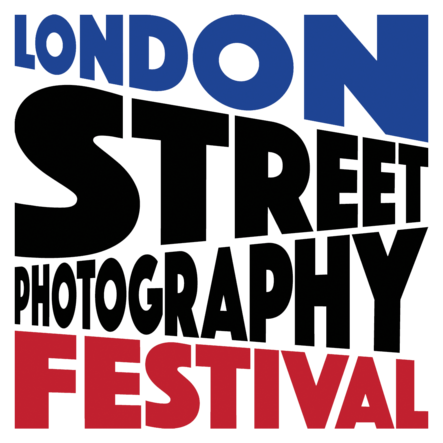 Yet, for all the institutional troubles at Photofusion, a booming interest in street photography, which had quietly gathered momentum since Nick Turpin’s founding of the in-Public collective in 2000, seemed to offer new opportunities for Halliday. 2011 saw in the launch of the inaugural and highly successful London Street Photography Festival (LSPF) which, in addition to representing many members of the in-Public collective, also invited Martin Parr to participate. Parr not only contributed to the festival but went on to select images from that festival to show at the prestigious Les Rencontres d’Arles photo festival the following year and, in doing so, helped revitalise interest in contemporary street photography.
Yet, for all the institutional troubles at Photofusion, a booming interest in street photography, which had quietly gathered momentum since Nick Turpin’s founding of the in-Public collective in 2000, seemed to offer new opportunities for Halliday. 2011 saw in the launch of the inaugural and highly successful London Street Photography Festival (LSPF) which, in addition to representing many members of the in-Public collective, also invited Martin Parr to participate. Parr not only contributed to the festival but went on to select images from that festival to show at the prestigious Les Rencontres d’Arles photo festival the following year and, in doing so, helped revitalise interest in contemporary street photography.
Either the LSPF festival or the Arles show might have been high-profile exhibition opportunities for Halliday except, however, he was not part of LSPF and, therefore, not available for Parr’s selection for Arles. On the opening night of the LSPF festival, marked by the opening of an exciting exhibition of women street photographers at Photofusion, Halliday staged his own, non-festival event at Whitechapel Gallery, in which he discussed his own street photography of London, an extended project which he called Urban Detours.[25]
Urban Detours was, even by 2011, already old work. Describing it for London Independent Photography magazine in 2006, Halliday wrote: ‘This summer will see the completion of a twenty-year photography project focusing on London’s streets and public places. I decided to initiate the project whilst completing the London College of Printing (now the London College of Communication) diploma in photojournalism in 1986’[26].
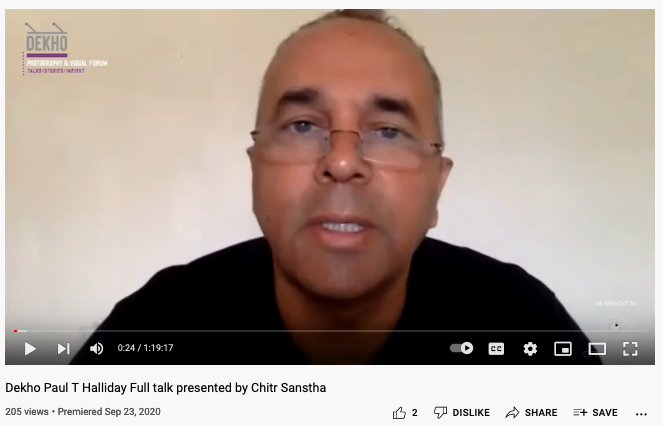
Paul T Halliday, Dekho, Youtube, 2020-09-23, screenshot
Its exact dates frantically oscillate thereafter, perhaps in an attempt to appear current and, therefore, relevant. Helen Thomas and Jamilah Ahmed’s Cultural Bodies: Ethnography and Theory (2008) noted that Halliday was ‘currently completing a 12-year photographic and film project focusing on street cultures in London’[27]. Five years later, in 2013, when Halliday’s partner, Roxanne Baptiste, interviewed him for his own <www.critiqueofstreetphotography.org> website, the project had elongated back to 20 years, encompassing ‘images of places in London that were also shown in the Channel 4 documentary `Living With The Bunker’ which you directed in 1994’[28]. In an interview for <PersonalWork.Online> in 2020, confusingly titled ‘Paul Halliday, Course Leader Goldsmiths MA Photography & Urban Cultures, on why he’s spending 20 years photographing London’, the project snaps back to a twenty-year one with the original dates, ‘launched at a Tate Modern conference in 2006’[29].
Without doubt, Urban Detours was, and continues to be, Halliday’s magnum opus. It was the sole content of <www.paulhalliday.org> which ran from circa 2007 to 2018, and the principal focus, too, of the recently defunct <www.critiqueofstreetphotography.org>. Tragically, for Halliday, no-one has ever seemed much interested. Recently, the newest iteration of Halliday’s twenty-year project has been an extended YouTube presentation which, at the time of writing, had received 182 hits, 2 likes, and 4 dislikes.[30]
Critical indifference to his Urban Detours project seems to have spurred Halliday into action. In 2012 he founded his own Urban Photo Fest[31] and an academically minded International Association of Visual Urbanists[32], clearly in competition to the London Street Photography Festival and the in-Public collective from which he’d been excluded the previous year. But still the critical indifference and exclusion rankled.
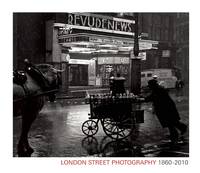
Mike Seaborne and Anna Sparham, eds., London Street Photography 1860-2010 (2012), cover
In late 2011, the Museum of London – a stakeholder in LSPF – published London Street Photography, 1860-2010, edited by their Senior Curator of Photographs, Mike Seaborne, and Anna Sparham. in-Public’s founder, Nick Turpin, and Parr were both invited to contribute but Halliday was not. His response was the aforementioned <www.critiqueofstreetphotography.org>, a personal website for which his partner, Roxanne Baptiste, interviewed him. The interview, approximately 7,000 words in length, is vitriolic, resentful, and uneasily grandiose in its claims.
Unchecked, Halliday convolutedly asserts that his Stephen Lawrence documentary ‘made history as the first Channel 4 film about a London street photographer to reach a mass audience’. And, of Seaborne’s book, he says:
[A]ny publication that purports to give a history of street photography in London, by definition would have needed to make reference to the work of Marketa Luskacova, Rut [Blees Luxemburg], Mark [Power] and myself. I don’t say that as an egotistical thing; rather, I say it as a statement of fact. [33]
Luskačová and Luxemburg would be quickly mobilised, too, to take a pot shot at Sophie Howarth and Stephen McLaren’s highly successful book Street Photography Now (2010), which had also featured Parr and Turpin but not Halliday. For Halliday, their exclusion – which, as we have seen, was also a proxy for his own exclusion – quickly became a smoking gun for the publication’s ‘‘mate-ology’ […] in the section labouring under the title ‘Reclaiming the Streets’, Halliday told his partner, ‘a disproportionate number of those were from In-Public’[34]. …
•
Notes:
[1] Twitter. (2021). [online] Available at: https://twitter.com/PaulTHalliday/status/1133135558098788352 [Accessed 11 Jun. 2021].
[2] M. Kruijt. (2020). Martin Parr, Icon of British Photography, in Disgrace After Being Accused of Racism. [online] de Volkskrant. Available at: https://www.volkskrant.nl/cultuur-media/martin-parr-icon-of-british-photography-in-disgrace-after-being-accused-of-racism~ba5a826c/ [Accessed 11 Jun. 2021].
[3] Twitter. (2021). [online] Available at: https://twitter.com/PaulTHalliday/status/1282704019341955078 [Accessed 11 Jun. 2021].
[4] Twitter. (2021). [online] Available at: https://twitter.com/PaulTHalliday/status/1288039287359971329 [Accessed 11 Jun. 2021].
[5] Twitter. (2021). [online] Available at: https://twitter.com/PaulTHalliday/status/1288849077585797123 [Accessed 11 Jun. 2021].
[6] Twitter. (2021). [online] Available at: https://twitter.com/PaulTHalliday/status/1343976635842879496 [Accessed 11 Jun. 2021].
[7] Twitter. (2021). [online] Available at: https://twitter.com/amolitor99/status/1134171620061302784 [Accessed 11 Jun. 2021].
Twitter. (2021). [online] Available at: https://twitter.com/amolitor99/status/1141471572789567488 [Accessed 11 Jun. 2021].
[8] Twitter. (2021). [online] Available at: https://twitter.com/amolitor99/status/1134171620061302784/retweets/with_comments [Accessed 11 Jun. 2021].
[9] Twitter. (2021). [online] Available at: https://twitter.com/LTHdebate/status/1141842389406867456 [Accessed 11 Jun. 2021].
[10] T. Seymour. (2020). ‘Martin Parr’s resignation from photo festival sparks “cancel culture” debate.’ [online] Theartnewspaper.com. Available at: https://www.theartnewspaper.com/news/martin-parr-s-festival-abdication-sparks-cancel-culture-debate [Accessed 12 Jun. 2021].
[11] T. Seymour. (2020). Martin Parr steps down as artistic director of Bristol Photo Festival after student’s anti-racism campaign. [online] Theartnewspaper.com Available at: https://www.theartnewspaper.com/news/martin-parr-stood-down-from-bristol-photo-festival-after-student-anti-racism-campaign [Accessed 12 Jun. 2021].
[12] Twitter. (2021). [online] Available at: https://twitter.com/TomSeymour/status/1285637076298485764 [Accessed 12 Jun. 2021].
[13] T. Seymour. (2020). Photo finish? Dubious practices in the firing line. The Art Newspaper, September 2020 [print edition].
[14] L. Bakare. (2020). UK photography body removes image “playing to racist stereotypes.” [online] the Guardian. Available at: https://www.theguardian.com/artanddesign/2020/jul/02/uk-photography-body-removes-image-playing-to-racist-stereotypes [Accessed 11 Jun. 2021].
[15] Twitter. (2021). [online] Available at: https://twitter.com/PaulTHalliday/status/1278765518854504454 [Accessed 11 Jun. 2021].
[16] Twitter. (2021). [online] Available at: https://twitter.com/LTHdebate/status/1278760828469235713 [Accessed 13 Jun. 2021].
[17] M. Govinda. (2020). The cancellation of Martin Parr. [online] Spiked-online.com. Available at: https://www.spiked-online.com/2020/07/27/the-cancellation-of-martin-parr/ [Accessed 11 Jun. 2021].
[18] M. Kruijt. (2020). Martin Parr, Icon of British Photography, in Disgrace After Being Accused of Racism. [online] de Volkskrant. Available at: https://www.volkskrant.nl/cultuur-media/martin-parr-icon-of-british-photography-in-disgrace-after-being-accused-of-racism~ba5a826c/ [Accessed 11 Jun. 2021].
[19] Twitter. (2021). [online] Available at: https://twitter.com/PaulTHalliday/status/1326330205514960896 [Accessed 11 Jun. 2021].
[20] Twitter. (2021). [online] Available at: https://twitter.com/PaulTHalliday/status/1378425346048024578 [Accessed 12 Jun. 2021].
[21] A. Bland. (2020). Edward Colston statue replaced by sculpture of Black Lives Matter protester Jen Reid. [online] the Guardian. Available at: https://www.theguardian.com/world/2020/jul/15/edward-colston-statue-replaced-by-sculpture-of-black-lives-matter-protester [Accessed 13 Jun. 2021].
[22] Archive.org. (2016). Critique of Street Photography – Interview with Paul Halliday. [online] Available at: https://web.archive.org/web/20180830210013/http://critiqueofstreetphotography.org/interview.html [Accessed 13 Jun. 2021].
[23] E. Gibb. (1994). The List: 4 Nov 1994 (Issue 240). [online] Available at: https://archive.list.co.uk/the-list/1994-11-04/85/. [Accessed 7 Jul. 2021].
[24] Archive.org. (2016). Critique of Street Photography – Interview with Paul Halliday. [online] Available at: https://web.archive.org/web/20190209215528/http://www.critiqueofstreetphotography.org/interview.html [Accessed 13 Jun. 2021].
[25] Flickr. (2020). Flickr, Paul Halliday and Photographing Society. Flickr, 3 Oct. 2020. [online] Available at: https://www.flickr.com/groups/instruction36/discuss/72157626775888175/. [Accessed 13 Jun. 2021].
[26] P. Halliday, P. Kilsby, B. Keane, B. and J. Rhodes, (2006). [online] London Independent Photography. Available at: https://www.londonphotography.org.uk/magazine/pdf/2006_Summer.pdf. [Accessed 7 Jul. 2021].
[27] H. Thomas and J. Ahmed, eds. (2008). Cultural Bodies: Ethnography and Theory. Oxford: Blackwell, p.ix.
[28] Archive.org. (2016). Critique of Street Photography – Interview with Paul Halliday. [online] Available at: https://web.archive.org/web/20190209215528/http://www.critiqueofstreetphotography.org/interview.html [Accessed 13 Jun. 2021].
[29] Personal Work. (2020). Paul Halliday, Course Leader Goldsmiths MA Photography & Urban Cultures, on why he’s spending 20 years photographing London. – Personal Work. [online] Available at: https://personalwork.online/paul-halliday-course-leader-goldsmiths-ma-photogrpahy-urban-cultures-on-why-hes-spending-20-years-photographing-london/ [Accessed 13 Jun. 2021].
[30] Chitr Sanstha (2020). Dekho Paul T Halliday Full talk presented by Chitr Sanstha. YouTube. Available at: https://www.youtube.com/watch?v=AAQtN63vwj4 [Accessed 20 Jun. 2021].
[31] Archive.org. (2011). [online] Available at: https://web.archive.org/web/20121203055940/http://urbanphotofest.org/home/ [Accessed 7 Jul. 2021].
[32] International Association of Visual Urbanists. (2017). [online] Available at: https://iavu.org/index.html [Accessed 7 Jul. 2021].
[33] Archive.org. (2016). Critique of Street Photography – Interview with Paul Halliday. [online] Available at: https://web.archive.org/web/20190209215528/http://www.critiqueofstreetphotography.org/interview.html [Accessed 13 Jun. 2021].
[34] Archive.org. (2016). Critique of Street Photography – Interview with Paul Halliday. [online] Available at: https://web.archive.org/web/20190209215528/http://www.critiqueofstreetphotography.org/interview.html [Accessed 13 Jun. 2021].
•
© Copyright 2021 by Dennis Low. All rights reserved. For reprint permissions, other usages, and questions, please contact the author: dennis(at)takemetothekittens(dot)com.






Reading the first three parts of Dennis Low’s Guest post I feel just mildly aggrieved at how I (along with everyone else) appear to have been deliberately misled by Paul Halliday, although this seems more to be about creating a publicity stunt rather than the meat of the issue.
Back in 2020 I wrote a short piece on >Re:PHOTO about the campaign against the book and some of the issues photographers face in photographing people back in 2020, but I didn’t really address the issue of whether it’s publication warranted the response it received.
Back in 1969 when Gian Butturini published London, things were viewed very differently and I think in the UK we would then probably have interpreted the pair of pictures as showing how both caged animals and low paid humans are degraded, imprisoned and exploited by society, seeing it more in class than in racial terms. Many of the worst paid jobs in the UK were and still are done by recent immigrants who at that time were largely from the Caribbean and Indian sub-continent.
It was a book I didn’t buy in 1969 nor when it was republished, because I found it of little interest – for me the images were not particularly good examples of an approach I very consciously rejected when beginning my own photographic work around this time.
There are many books included in Gerry Badger and Martin Parr’s catalogues of photobooks that I think would best be forgotten and are perhaps included more for their rarity than for their quality or influence. I think this particular re-publication was a mistake because it was not worth reprinting, but also feel that the pairing of these two pictures was predictably controversial in 2020 in a way it had not been in 1969. A sensible publisher would have thought more carefully about it. And I don’t know anyone other than Paul Halliday who bought a copy.
I have some personal interest in the matters in the posts. I’ve often admired the stand over matters of photographic ethics by ‘duckrabbit’ in his blog and know at least slightly most or all of the photographers mentioned. For years I was a contributor to the Photofusion library, and regularly attended exhibition openings there, talking occasionally with Paul Halliday, though I doubt if he remembers me, though I knew others there well, and am dismayed at what has happened to Photofusion which was once one of very few vital parts of a rather minimal UK photography community.
I was pleased to be included in the book London Street Photography, and that my picture was used in publicity for the show. The book seemed a good overview of the area but certainly not comprehensive, and I disagree with Halliday’s comments. Anyone who thinks it would have been appropriate to include Rut Blees Luxemburg has a different perception of ‘street photography’ to me – though it’s always been a woolly term I’ve tried to avoid.
And I’m afraid its a fact for me that after viewing the images Halliday includes in his YouTube video on his London project and listening to his comments I find myself largely in agreement with the lengthy and rather negative review of it by Andrew Molitor at http://photothunk.blogspot.com/2020/09/crit-london-by-paul-halliday.html
I know or knew at least slightly around 20 (some now deceased) of those in the more recent sections of London Street Photography as well as its editors – and have around a hundred pictures in the Museum collection and had work in several shows there and in the linked Museum of London Docklands. I can think of at least a dozen other photographers I would have liked to be in the book had I been its editor and they were willing to take part – including Marketa Luskacova who I never met, though we sometimes walked the same streets. There are also just a few I would have left out – but of course that doesn’t make it a bad book.
Thanks for your thoughtful response to this series to date. Good to have some more insight from that side of the pond, especially from someone whose experience goes back to the time period in which this book originally appeared.
As I indicate in my introduction to Low’s analysis, I don’t have a dog in this fight. I still haven’t seen the entire book, which — since the edition was withdrawn by its publisher — is quite scarce over here. So I don’t have an opinion about it, having laid eyes on only a few sample spreads.
Speaking strictly of the controversial spread, taken out of context, I agree with you that “the pairing of these two pictures was predictably controversial in 2020 in a way it had not been in 1969.” I started my own work as a critic in 1968, not long before this book came out. So I can say that, given the context of the complete book as I understand it from the excerpts I’ve seen, at the time I probably would have voiced a take on this pairing similar to yours — even given my U.S.-centric perspective.
I also think that Parr could have defused any prospective uproar by addressing that diptych directly, quoting Butturini’s own comments on the juxtaposed images and offering a nuanced reading like yours. But that’s hindsight speaking.
I was involved, peripherally, in the twitter-fight. It struck me pretty early on as more about people wanting to have a twitter-fight than about anything else (although surely there was *some* genuine concern about issues of racism and racist imagery.)
If it has not yet occurred, I expect AD will be receiving emails featuring the word “problematic” and urging him to take Dr. Low’s piece down, and when he doesn’t, he will be quietly added to an enemies list. With no actual effect, I have been on that same list for some years now, and so far so good.
The book itself interested me out of proportion to its importance, probably because I just like the thing. I’ve written a ridiculous amount of material about it, and it continues to inform my thoughts. Even now I am seriously thinking about how a juxtaposition of photos actually functions.
I appreciate the shout-out to my review, Peter! That’s very kind of you.
AD, I own a copy of the book and would be happy to send it on to you. I will contact you by email.
Thanks for your kind and unexpected offer.
If I accept, I’ll feel obligated to justify you taking that trouble by writing a review. Which I’m not inclined to do. Not because I fear thereby earning a spot on someone’s enemies list, but because I don’t think I have much to add to the debate, and thus don’t see much purpose to it.
Meanwhile, you’ve put a lot of focused energy into this brouhaha. So I think your copy should remain with you.
As it happens, I have a colleague who owns a copy of the new edition, and will check it out through him.
Once again, I appreciate the offer. As well as your regular references to my blog, wherein you quote me accurately and usually take my meaning correctly. As well as your blog in general — a small point of light.
Not incidentally, I have indeed received backstage correspondence from several of the principals suggesting that I will come to regret publishing Dennis Low’s analysis. Amusing.